S & J Tree Farm and Nursery’s Guide to Growing
Tuskegee Crape Myrtle
Trees in the Northeast Florida Landscape
( Lagerstroemia indica x fauriei ‘Tuskegee’ )
Crape Myrtle Tuskegee Preferred Exposure:
– Full sun is needed for Tuskegee Crape Myrtles to grow and bloom at their
best in the Northeast Florida | Jacksonville | St. Augustine area gardens landscape.
Tuskegee Crape Myrtle Foliage | Bark:
– Foliage emerges with a burgundy or red tinge when young aging to a dark green. Deciduous foliage will turn an orange red color in fall before dropping to the ground for its dormant winter
season.
– Bark of the Tuskegee Crape Myrtle is distinctive having fluted grooves that run longitudinally along the trunk of the tree. Bark coloring is a mottled grayish brown and tan color.
Tuskegee Crape Myrtle Soil Preference / Salt Tolerance:
– Tuskegee Crape Myrtles are not picky about the components
that make up the soil and will do well in most soils providing they are well draining.
– Crape Myrtle trees are not known to be salt tolerant and
should not be planted in areas where salt spray will reach them from the ocean or where highly saline water is used for irrigating.
Tuskegee Crape Myrtle Size Variance:
– Tuskegee Crape Myrtle is one of the larger growing selections of Crape Myrtles that we sell here at S & J Tree Farm and Nursery. They
will reach to 20′ high and 20′ wide at maturity making a handsome
specimen tree or small scale shade tree for our Northeast Florida Landscape.
Crape Myrtle Tuskegee Growth Habit:
– Upright rounded growth habit with plenty of horizontal branches forms a very pretty crown of foliage that will be decorated by large blooms for three months during the heat of
summer.
Crape Myrtle Tuskegee Growth Rate:
– Due to its larger mature size Tuskegee is a moderate to
fast growing selection of lagerstroemia.
Tuskegee Crape Myrtle Bloom:
– Large deeply colored hot pink to red blooms are 6-9 inches long and 5-7 inches wide. The bloom is just ever so slightly lighter that Tonto, ( one of my personal favorite color selections) so much so that you can barely notice the difference when the two are held right up next to each other.
Crape Myrtle Tuskegee Water Requirements:
-Crepe Myrtles trees are drought tolerant after they are established in the
landscape but will need to be watered well after planting for two weeks to three months in the establishment period. Water a minimum of once weekly after your tree is established in the landscape or during prolonged
periods of drought.
Butterfly or Bird Attracting:
– n/a
Best Uses For Crape Myrtles:
– Few trees make quite the statement in the landscape that a Crape Myrtle can. They bloom for months with little care on our part to keep them looking spectacular. There is little wonder they hold such a place in our hearts and gardens. You just can’t go drive anywhere in the South during the summer blooming season and not fall in love with Crape Myrtle trees!
– Plant them alone as a specimen accent or in groups for added dramatic flare. With so many varieties, colors and sizes to choose from, no southern garden should be without at least one!
– Crape Myrtles are the perfect touch of color when interplanted in hedge rows for privacy screens or property borders.
– Low maintenance and drought tolerant once established, Crape Myrtles make excellent commercial plantings for parking lots and street trees.
Care of Crape Myrtles:
– Water every day during the establishment period. See watering your newly planted trees for more information.
-They will need good water during the establishment period and supplemental irrigation during dry spells or particularly hot dry summers.
– All Crape Myrtles bloom on new wood and should be pruned in winter or early spring for best bloom.
– Take care to remove basal suckers and small twiggy growth each year on larger specimens and remove crossing or touching branch growth as well as branches growing towards the center rather than the more desirable growth that grows out and away from other branches.
– During the summer growth season you can choose to trim old blooms and your Crape Myrtle will put out a second lighter and slightly smaller bloom to replace it and prolong your bloom season.
– Provide a 1 ft diameter circle of mulched area where grass is kept from growing for each inch of caliper (or diameter) of trunk measured 4 inches from the ground level.
– Fertilize each spring with a heaping shovel of compost or a mixture of Milorganite and a slow release poly coated plant food such as Osmocote or Stay Green general purpose plant food, sprinkling the fertilizer around the mulch circle underneath the foliage of the tree.

